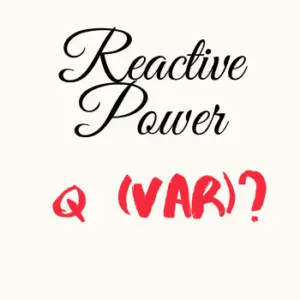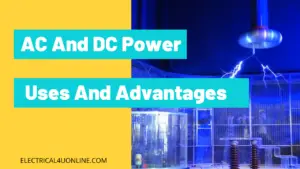Understanding the distinction between apparent power and actual power is crucial in the field of electrical systems.
While these terms are often used interchangeably, they represent different aspects of power consumption.
Recognizing the difference between them is essential for efficient power management and ensuring the optimal functioning of electrical equipment.
In this article, we will delve into the reasons why apparent power is more than actual power, exploring the various factors and concepts involved.
As a short answer, apparent power is more than actual power due to the inclusion of reactive power and factors like power factor, inductive and capacitive loads, harmonics, and non-linear loads in electrical systems. Let’s go into deep details.
Table of Contents
Understanding Apparent Power
Apparent power refers to the total power that is drawn from an electrical system, combining both the real and reactive power components.
It is measured in volt-amperes (VA) and represents the magnitude of the overall power flow.
Apparent power is calculated by multiplying the voltage and current values of the electrical system without taking into account the phase difference between them.
Read my other comprehensive article: Unpacking the Mystery of Apparent Power and Reactive Power.
Understanding Actual Power
Actual power, also known as real power, is the component of power that performs useful work in an electrical system.
It is measured in watts (W) and represents the power that is effectively consumed by resistive loads.
Actual power is obtained by considering the phase difference between voltage and current and multiplying them with the power factor, which reflects the efficiency of power utilization.
Why Apparent power is greater than real power?
Apparent power is greater than actual power because it takes into account not only the real power but also the reactive power in electrical systems.
Reactive power is the power consumed by inductive and capacitive loads, which do not directly contribute to performing useful work but are necessary for establishing and maintaining magnetic or electric fields.
When calculating apparent power, the additional power required for reactive loads is included, resulting in a higher overall power value.
Factors such as power factor, inductive and capacitive loads, harmonics, and non-linear loads further contribute to the difference between apparent power and actual power.
Therefore, apparent power encompasses both the real power that performs useful work and the reactive power components, making it larger than actual power.
Factors Influencing the Discrepancy between Apparent Power and Actual Power
Several factors contribute to the difference between apparent power and actual power.
One significant factor is reactive power, which arises from inductive and capacitive loads in electrical systems.
These loads require an additional amount of power to establish and maintain magnetic or electric fields, contributing to the apparent power without performing any useful work.
Harmonics and non-linear loads also contribute to the apparent power. Non-linear loads, such as electronic devices, introduce distortions in the current waveform, leading to harmonic currents.
These harmonics further increase the total current flow and, consequently, the apparent power.
The Relationship between Apparent Power and Actual Power
The relationship between apparent power and actual power can be visualized using a power triangle, which illustrates the interplay between real power, reactive power, and apparent power.

The power factor, defined as the ratio of actual power to apparent power, determines the efficiency of power usage in an electrical system.
A power factor of 1 indicates that all the power drawn is utilized effectively, while a power factor less than 1 signifies a portion of the power being wasted.
Read my article Power Factor Correction: 8 Important Answers, for more information on Power factor.
Real-World Examples of Apparent Power vs. Actual Power
In residential and commercial electrical systems, apparent power plays a crucial role in determining the sizing and rating of electrical equipment.
Overlooking the reactive power component can lead to undersized equipment, resulting in power losses, reduced efficiency, and potential equipment failures.
Similarly, in industrial power systems and renewable energy installations, understanding the difference between apparent power and actual power is vital for proper equipment selection and system design.
Significance of Apparent Power in Electrical Systems
Apparent power has significant implications for power systems. Efficient power factor management helps improve the overall system efficiency, reduces energy losses, and optimizes the utilization of electrical equipment.
Additionally, considering the apparent power is crucial for accurate billing, as utilities often charge consumers based on both actual and reactive power consumption.
Managing Apparent Power in Electrical Systems
To manage the apparent power and improve the power factor, various techniques can be employed. Power factor correction techniques, such as capacitor banks and static VAR compensators, can offset the reactive power component and improve the power factor.
Reactive power compensation can be achieved by using devices like synchronous condensers or active power filters.
Additionally, load balancing helps distribute the load evenly across phases, minimizing power imbalances and improving the overall power factor.
Future Trends and Innovations in Power Management
Advancements in power management focus on developing smart grids and intelligent power systems.
These systems incorporate advanced metering, real-time monitoring, and control mechanisms to optimize power usage and maintain a stable power factor.
Furthermore, the integration of renewable energy sources into the grid necessitates efficient management of both apparent power and actual power, ensuring maximum utilization of renewable energy resources.
Conclusion
Apparent power is more than actual power due to the inclusion of reactive power and factors like power factor, inductive and capacitive loads, harmonics, and non-linear loads in electrical systems.
Understanding why apparent power is more than actual power is crucial for effective power management in electrical systems.
By considering the factors influencing the difference, recognizing the relationship between the two, and implementing appropriate management techniques, power systems can operate more efficiently, reducing energy losses and improving overall performance.
Embracing these concepts will lead to a sustainable and optimized power infrastructure for the future.
Install my Free Android App on Google Play:
Electrical Cables Most Common Tables
And, my Electrical Calculations App “”
Discover more great content by subscribing to My channel
Looking to stay ahead of the game in the world of electrical engineering? Subscribe to my YouTube channel and gain access to exclusive content you won’t find anywhere else!
The staff I recommend
(Amazon Affiliate Links to products I believe are high quality):
- Economy 120 Volt/60Hz AC Power Source – Step-Down Voltage & Frequency Converters 1800W
- UNI-T Digital Multimeter Tester UT139C
- 50-Amp Extension Cord for RV “100ft”
- Voltage Stabilizer 110/220v
- Hair Dryer “best selling“
- TOSHIBA EM131A5C-BS Countertop Microwave Ovens
Disclaimer: This contains affiliate links to Amazon products. I may earn a commission for purchases made through these links.



